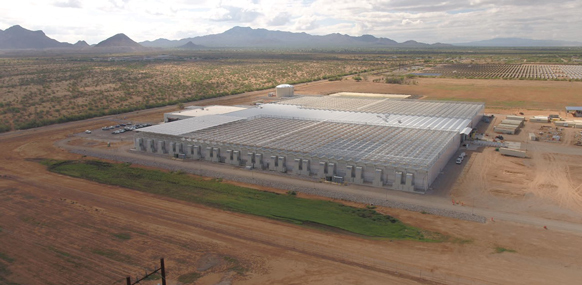Marana, Arizona, USA
March 4, 2020

- The unique Marana Greenhouses will serve as a global product design center for corn
- By bringing the breeding process indoors, more seed products can be developed faster, resulting in farmers benefitting from the latest technology
- Bayer’s investment in the Marana site reflects the company’s commitment to sustainability
To further its global commitment of providing growers with the most innovative, sustainable and technically-advanced agricultural solutions, Bayer has opened its new smart, state-of-the-art, automated greenhouse facility in Marana, Ariz.
The Marana Greenhouse facility is the first of its kind for the company and the most technically advanced. The approximately USD 100 million facility will serve as a global product design center for corn, the only crop to be grown there. Additionally, the Marana facility will capitalize on innovation advancements in proprietary seed chipping, advanced marker technology, automation and data science.
“With our new Marana greenhouses, Bayer is reimagining the way plant breeding is done and setting the standard for environmental sustainability,” said Bob Reiter, Head of Research and Development for Crop Science at Bayer. “Meeting the unique challenges that farmers face requires different ways of thinking and working, and this new innovative facility is one of the many ways Bayer will deliver on its commitments to farmers.”
The Marana greenhouses, which occupies 300,000 square feet of growing space, are designed for the sustainable use of inputs throughout the research process. Water used for crops will be recycled, which helps preserve precious desert water supplies, 100 percent of harvested materials will be used for compost and beneficial insects will be used to reduce pesticide applications.
By locating the Marana Greenhouse facility in the Arizona desert instead of the midwestern section of the United States where corn is traditionally grown, more days of warmth and sunlight will allow researchers to maintain plants year-round, enabling three to four corn crop cycles annually. Also, by utilizing the controlled environment of the greenhouses, the breeding process comes indoors which eliminates crop exposure to adverse weather conditions and prevents delays in new seed development. Growing conditions can be customized to simulate various climate conditions around the world.
“Every investment in innovation is an investment in more sustainable agriculture for the next generation, and the effects travel far beyond one site,” added Reiter. “The corn hybrids developed here, under diverse growing environments and weather scenarios, will bring innovation to growers in every part of the world.”
Nachhaltigere Agrarlösungen aus neuen und innovativen Gewächshäusern in der Wüste Arizonas
- Marana Greenhouses werden zum globalen Produktdesignzentrum für Mais
- Züchtungsprozess unter Dach erlaubt größere und schnellere Saatgutproduktion
- Investition in den US-Standort Marana zeigt Engagement für Nachhaltigkeit
Bayer eröffnet heute seine neue, moderne und weitgehend automatisierte Gewächshausanlage in Marana im US-Bundesstaat Arizona. Forscher arbeiten dort an innovativen Lösungen und Landwirte werden demnächst von hier mit nachhaltigem und technisch fortschrittlichem Saatgut beliefert.
Das Marana Greenhouse ist die technisch fortschrittlichste Züchtungsstation des Unternehmens. Die 100 Millionen US-Dollar (ca. 90 Millionen Euro) teure Anlage dient als globales Produktdesignzentrum für Mais – die einzige Kulturpflanze, die dort angebaut werden soll. Die Züchtungsstation wird von innovativen Lösungen in den Bereichen Saatgutbeprobung (Chipping), fortschrittliche Marker-Technologie, Automatisierung und Datenwissenschaft profitieren.
„Mit den Gewächshäusern in Marana beschreitet Bayer neue Wege in der Pflanzenzucht und setzt Maßstäbe bei der Nachhaltigkeit“, sagte Bob Reiter, Leiter Forschung und Entwicklung in der Bayer-Division Crop Science. „Die Bewältigung der großen Herausforderungen, vor denen Landwirte stehen, erfordert andere Denk- und Arbeitsweisen. Diese neue innovative Züchtungsstation ist eine von vielen Möglichkeiten, wie Bayer seine Verpflichtung gegenüber den Landwirten erfüllen wird.“
Die Gewächshäuser in Marana, die sich über fast 28.000 Quadratmeter Anbaufläche erstrecken, sind für eine nachhaltige Betriebsmittelnutzung während des gesamten Prozesses ausgelegt. Das für die Pflanzen verwendete Wasser wird recycelt. Dies trägt dazu bei, die wertvollen Wasservorräte der Wüste von Arizona zu schonen. 100 Prozent der Ernteabfälle werden als Kompost verwendet, und Nützlinge sollen dabei helfen, den Einsatz von Pestiziden zu reduzieren.
Der Standort der Züchtungsstation in der Wüste von Arizona anstatt im Mittleren Westen der Vereinigten Staaten, wo Mais seit Jahrzehnten angebaut wird, garantiert eine größere Anzahl an warmen und hellen Tagen. Dies ermöglicht es, Pflanzen über das ganze Jahr hinweg zu züchten und so von drei bis vier Erntezyklen jährlich zu profitieren. In der kontrollierten, geschlossenen Umgebung der Gewächshäuser werden die Kulturpflanzen bei der Züchtung vor ungünstigen Witterungsbedingungen geschützt und Verzögerungen in der Entwicklung von neuem Saatgut vermieden. Durch digital veränderbare Anbaubedingungen in den Treibhäusern lassen sich verschiedene klimatische Verhältnisse in der Welt simulieren.
„Jede Investition in Innovation ist für uns eine Investition in nachhaltigere Landwirtschaft für die nächste Generation und entfaltet ihre Wirkung weit über einen einzelnen Standort hinaus“, ergänzte Reiter. „Von den innovativen Maishybriden, die hier in vielfältigen Anbauumgebungen und unter verschiedenen Witterungsbedingungen entwickelt werden, profitieren Landwirte auf der ganzen Welt.“